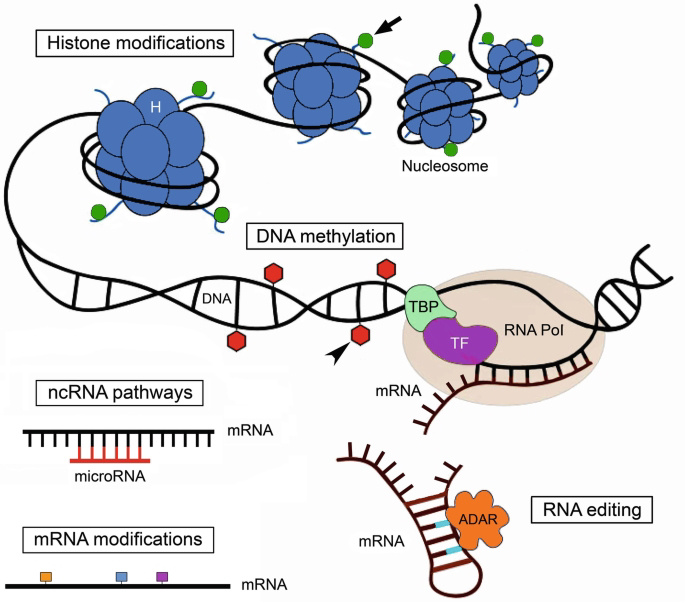Missing Links: Dethroning the Neo-Darwinian King with Epigenetics and Phenotypic Plasticity
Missing Links: Dethroning the Neo-Darwinian King with Epigenetics and Phenotypic Plasticity
The tale of evolution has long been dominated by the Neo-Darwinian narrative, a stoic monarch presiding over the realm of adaptation. Its reign, built on the pillars of natural selection and genetic mutations, has shed light on countless biological marvels. Yet, as with any long-held rule, cracks begin to appear in the Neo-Darwinian edifice, particularly when we confront the enigma of missing links – those elusive transitional fossils that bridge the gaps between major evolutionary leaps. Here, we propose a bold challenger to the Neo-Darwinian throne: a dynamic duo known as epigenetics and phenotypic plasticity, poised to explain these evolutionary ghosts with far greater nuance and grace.
Neo-Darwinism's Blind Spots: The Case of the Disappearing Ancestor
Neo-Darwinism posits that mutations in DNA, meticulously sculpted by natural selection, drive the engine of evolution. This process, however, can be frustratingly slow, particularly when it comes to explaining rapid bursts of phenotypic change or the emergence of complex traits. Missing links, often represented by fossilized fragments, stand as stark reminders of these evolutionary lacunae. The gaps between, say, a fish and an amphibian, or a dinosaur and a bird, remain frustratingly large, leaving us to rely on educated guesses and hypothetical ancestors to fill the void.
Enter the Epigenetic Revolution: Where Genes are Not Set in Stone
But what if the story of evolution isn't just about the hard, immutable code of DNA? This is where epigenetics, the study of heritable changes in gene expression that don't involve alterations in the DNA sequence itself, takes center stage. Imagine gene expression as a grand orchestra, where DNA is the sheet music and epigenetic modifications act as the conductor, dictating which instruments play and how loudly. These modifications, such as DNA methylation and histone acetylation, can turn genes on or off, fine-tuning an organism's response to its environment without changing the underlying genetic code.
The beauty of epigenetics lies in its speed and agility. Unlike mutations, which can take generations to be acted upon by natural selection, epigenetic changes can occur within an individual's lifetime, even in response to immediate environmental pressures. This allows organisms to rapidly adapt to changing conditions, express hidden genetic potential, and bridge the gap between generations, potentially explaining the sudden appearance of novel traits without requiring dramatic genetic leaps.
Phenotypic Plasticity: Dancing to the Environmental Tune
But evolution isn't a solo act. The environment plays a crucial role in shaping an organism's phenotype, the outward expression of its genes. This is where phenotypic plasticity takes the stage. Imagine an organism as a chameleon, its colors morphing to blend seamlessly with its surroundings. Phenotypic plasticity allows an organism to express different versions of its existing genes depending on the environmental context. A plant might grow taller in shade, a lizard darken its skin in colder temperatures, or a bird alter its song to attract mates in a new habitat.
The significance of phenotypic plasticity lies in its ability to create evolutionary "shortcuts." An organism doesn't need to wait for a fortuitous mutation to adapt to a new environment; it can simply tweak its gene expression or alter its development in response to existing environmental cues. This rapid and reversible adaptation can pave the way for future genetic changes, potentially laying the groundwork for the evolution of novel traits in subsequent generations, all without invoking the slow hand of natural selection.
Missing Links Reimagined: A Tapestry of Epigenetics and Plasticity
When we view evolution through the lens of epigenetics and phenotypic plasticity, the mystery of missing links begins to unravel. Imagine a fish exposed to increasingly dry conditions. Epigenetic modifications might repress genes for gill development and activate genes for lung formation, leading to the gradual emergence of amphibian-like features. Similarly, a dinosaur experiencing a cooling climate might alter its feather development through phenotypic plasticity, leading to the insulation necessary for avian flight. These "soft" inheritance systems can orchestrate rapid phenotypic changes within generations, potentially filling the gaps between major evolutionary transitions without requiring the fossilized remnants of hypothetical ancestors.
A New Evolutionary Landscape: Beyond the Neo-Darwinian Monolith
By acknowledging the dynamic interplay of epigenetics and phenotypic plasticity, we gain a richer understanding of how evolution truly unfolds. It's a story not just of genes and mutations, but of environmental cues, reversible adaptations, and the remarkable ability of organisms to dance to the rhythm of their surroundings.
The dethroning of the Neo-Darwinian king spells the change of evolution's grand narrative. It ushers in a new era of understanding, where epigenetics and phenotypic plasticity reign.
Ref:
https://link.springer.com/chapter/10.1007/978-3-031-47739-3_8
https://royalsocietypublishing.org/doi/10.1098/rstb.2020.0124
https://www.biorxiv.org/content/10.1101/2023.11.27.568862v1
https://onlinelibrary.wiley.com/doi/full/10.1002/jez.b.22571






Comments
Post a Comment